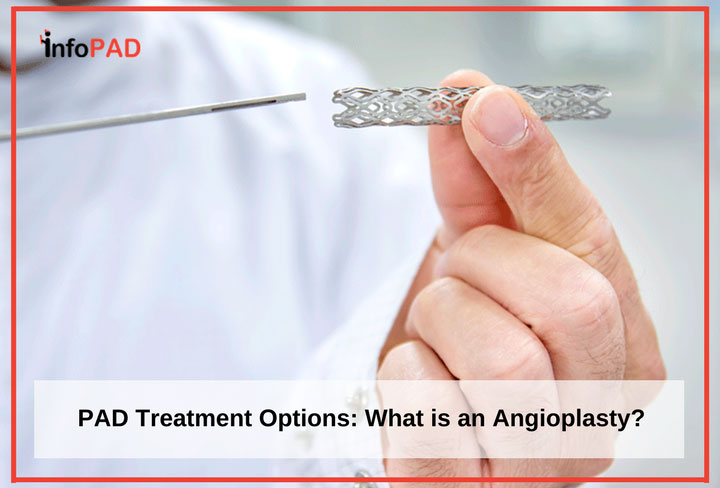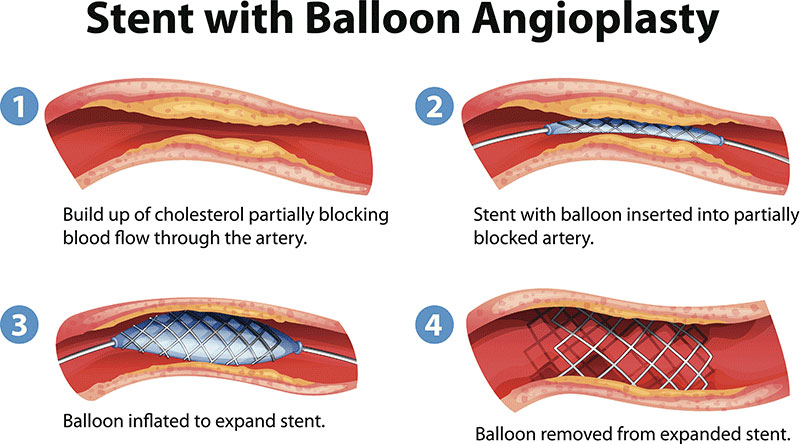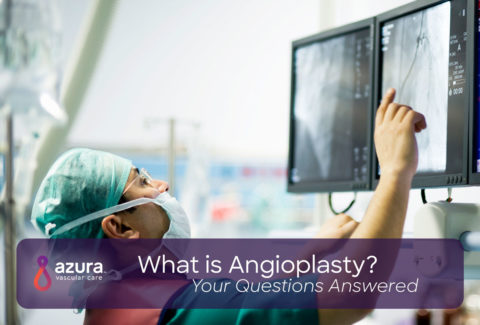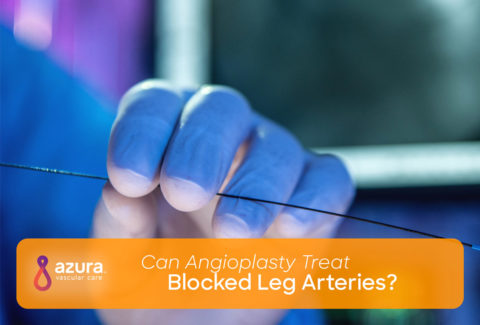
One in twenty Americans over the age of 50 has peripheral artery disease (PAD).i PAD occurs when the arteries in the peripheral limbs (most commonly in the legs) become narrowed or blocked with fatty deposits called plaque. These blockages may result in numbness, pain, and discomfort in the lower extremities. Left untreated, peripheral artery disease increases risk of heart attack, stroke, limb amputations, and even death. Peripheral artery disease treatments include both invasive and minimally invasive treatment options. The option that is chosen depends on the location and severity of the blockage.
What is an Angioplasty?
Angioplasty is a minimally invasive procedure used to open or expand arteries that have been narrowed, or blocked as a result of PAD. A small balloon is inserted in to a medical device called a catheter, a flexible tube that can be guided through a small incision that is typically made in the groin (alternative entry sites may be the foot or arm). After insertion, the catheter is guided through the blood vessel to the location of the blockage. Once at the appropriate location, the balloon is advanced through the catheter and inflated. As the balloon is inflated it pushes plaque deposits flat against the wall of the blood vessel, widening the artery and improving blood flow. Angioplasties can be conducted in a hospital catheterization lab or in an outpatient setting by a trained interventional radiologist or vascular surgeon.

What Are the Benefits of An Angioplasty?
- An angioplasty can immediately reduce discomfort, increase mobility, and improve blood flow to the heart and extremities. Additionally, an angioplasty can reduce the risk of heart attack or stroke and improve function of the kidneys.ii
- Angioplasties have been shown to have even better outcomes when used in combination with other treatments such as stenting and atherectomies.iii
Are There Any Disadvantages to An Angioplasty?
- Angioplasties carry the typical risks of minimally invasive procedures, including the risk of infection at the entry site.
- There is the possibility of a reaction to the contrast dye used to image the location of the blockage.
- While extremely unusual, it is possible that inflation of the balloon may weaken the arterial wall, or dislodge plaque deposits that settle downstream of the treated site.iv A skilled physician will generally not have this issue.
What Should I Expect?
Before the Procedure
- Before the procedure, pre-tests such as laboratory studies may be needed
- On the night before, a physician will provide the proper protocol for procedure preparation. A light dinner, followed by a midnight fast is typically recommended.
When You Arrive At the Outpatient Center…
- Consent forms will need to be signed, granting permission for emergency interventions in the rare event that they are needed.
- ECGs, or electrocardiograms, are sometimes conducted to confirm that the heart rate, rhythm, and general condition are healthy enough to proceed.
- The incision site will be shaved and washed to protect against infection.
During the Procedure…
- Intravenous sedatives will be given. The patient is kept relaxed, but awake during the procedure. Local anesthetics will be used to numb the incision site so that only pressure or pushing sensations are felt.
- An incision in the skin is made.
- The deflated balloon is inserted into a catheter; the catheter is inserted into the blood vessel and maneuvered to the location of the blockage. Live x-ray imaging is used to ensure proper placement.
- When the catheter is placed properly, the balloon will be advanced through the catheter to the site of the vessel narrowing and inflated, pressing the plaque against the artery wall and increasing blood flow.
- The angioplasty balloon is then deflated, and the entire balloon and catheter are withdrawn. In the event that angioplasty and stenting are performed together; once the angioplasty is done, the stent is inserted into the catheter, which is then advanced to the location of the vessel narrowing and expanded into place by an angioplasty balloon.
- The entire procedure takes approximately 45 minutes to 3 hours.
After the Procedure…
- Patients will be instructed to lie flat for 1 to 3 hours to ensure that blood flow has been safely restored, and then will be elevated to a seated position.
- Daily activity can resume within 24 to 48 hours, following the advice of the physician.
- Medications may be prescribed to help prevent clots from forming.
Why Would Your Physician Recommend An Angioplasty?
Angioplasties are used either alone or in combination with stenting and/or atherectomies. If a combination of treatments is utilized, there are lower chances of the artery becoming blocked or narrowed again. Angioplasty alone is frequently utilized when the blockage is in a small vessel that could be damaged by stent insertion.v
The sooner you are treated, the lower your risk of PAD progressing, which, if left untreated, may leave amputation as the only treatment option. If you have been diagnosed with PAD, contact an Azura Vascular Care center to learn more, or request an appointment.
Sources:
i https://www.nhlbi.nih.gov/health/educational/pad/docs/pad_extfctsht_general_508.pdf
ii http://www.secondscount.org/treatments/treatments-detail-2/benefits-risks-of-angioplasty-stenting#.ViQfe3ippFI
iii http://www.ncbi.nlm.nih.gov/pubmed/26612053
iv http://www.vascularweb.org/vascularhealth/pages/angioplasty-and-stenting.aspx
v http://www.webmd.com/heart-disease/angioplasty-for-peripheral-arterial-disease-of-the-legs


